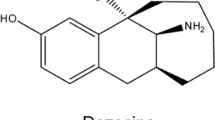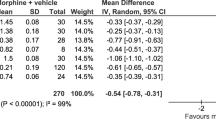Abstract
Despite substantial investment by the pharmaceutical industry over several decades, there has been little progress in developing new, efficacious and safe analgesics. As a result, many large pharmaceutical companies are leaving the area of pain medication. Nevertheless, the chances of success could increase if analgesic drug development strategy changed. To achieve such a paradigm shift we must understand why development of drugs for pain relief is so challenging.
This is a preview of subscription content, access via your institution
Access options
Subscribe to this journal
Receive 12 print issues and online access
$209.00 per year
only $17.42 per issue
Buy this article
- Purchase on Springer Link
- Instant access to full article PDF
Prices may be subject to local taxes which are calculated during checkout


Similar content being viewed by others
References
Basbaum, A.I., Bautista, D.M., Scherrer, G. & Julius, D. Cellular and molecular mechanisms of pain. Cell 139, 267–284 (2009).
Costigan, M., Scholz, J. & Woolf, C.J. Neuropathic pain: a maladaptive response of the nervous system to damage. Annu. Rev. Neurosci. 32, 1–32 (2009).
Lacroix-Fralish, M.L. & Mogil, J.S. Progress in genetic studies of pain and analgesia. Annu. Rev. Pharmacol. Toxicol. 49, 97–121 (2009).
McMahon, S.B. & Malcangio, M. Current challenges in glia-pain biology. Neuron 64, 46–54 (2009).
Häuser, W., Petzke, F. & Sommer, C. Comparative efficacy and harms of duloxetine, milnacipran, and pregabalin in fibromyalgia syndrome. J. Pain 11, 505–521 (2010).
Moore, R.A., Straube, S., Wiffen, P.J., Derry, S. & McQuay, H.J. Pregabalin for acute and chronic pain in adults. Cochrane Database Syst. Rev. CD007076 (2009).
Jensen, T.S., Madsen, C.S. & Finnerup, N.B. Pharmacology and treatment of neuropathic pains. Curr. Opin. Neurol. 22, 467–474 (2009).
Dworkin, R.H. et al. Recommendations for the pharmacological management of neuropathic pain: an overview and literature update. Mayo Clin. Proc. 85, S3–S14 (2010).
Attal, N. et al. EFNS guidelines on the pharmacological treatment of neuropathic pain: 2010 revision. Eur. J. Neurol. 17, 1113–e88 (2010).
Helfand, M. & Freeman, M. Assessment and management of acute pain in adult medical inpatients: a systematic review. Pain Med. 10, 1183–1199 (2009).
Straube, S., Derry, S., Moore, R.A. & McQuay, H.J. Pregabalin in fibromyalgia: meta-analysis of efficacy and safety from company clinical trial reports. Rheumatology (Oxford) 49, 706–715 (2010).
Finnerup, N.B., Otto, M., Jensen, T.S. & Sindrup, S.H. An evidence-based algorithm for the treatment of neuropathic pain. MedGenMed 9, 36 (2007).
Kissin, I. The development of new analgesics over the past 50 years: a lack of real breakthrough drugs. Anesth. Analg. 110, 780–789 (2010).
Latremoliere, A. & Woolf, C.J. Central sensitization: a generator of pain hypersensitivity by central neural plasticity. J. Pain 10, 895–926 (2009).
Woolf, C.J. & Salter, M.W. Neuronal plasticity: increasing the gain in pain. Science 288, 1765–1769 (2000).
Bradley, L.A. Pathophysiology of fibromyalgia. Am. J. Med. 122, S22–S30 (2009).
Chen, Y. Advances in the pathophysiology of tension-type headache: from stress to central sensitization. Curr. Pain Headache Rep. 13, 484–494 (2009).
Williams, D.A. & Clauw, D.J. Understanding fibromyalgia: lessons from the broader pain research community. J. Pain 10, 777–791 (2009).
Saito, Y.A., Mitra, N. & Mayer, E.A. Genetic approaches to functional gastrointestinal disorders. Gastroenterology 138, 1276–1285 (2010).
Fischer, T.Z. & Waxman, S.G. Familial pain syndromes from mutations of the NaV1.7 sodium channel. Ann. NY Acad. Sci. 1184, 196–207 (2010).
Tegeder, I. Current evidence for a modulation of low back pain by human genetic variants. J. Cell. Mol. Med. 13, 1605–1619 (2009).
Kehlet, H., Jensen, T.S. & Woolf, C.J. Persistent postsurgical pain: risk factors and prevention. Lancet 367, 1618–1625 (2006).
Van Zee, A. The promotion and marketing of oxycontin: commercial triumph, public health tragedy. Am. J. Public Health 99, 221–227 (2009).
Schneider, M.F. et al. Integrating nine prescription opioid analgesics and/or four signal detection systems to summarize statewide prescription drug abuse in the United States in 2007. Pharmacoepidemiol. Drug Saf. 18, 778–790 (2009).
Grosser, T., Yu, Y. & Fitzgerald, G.A. Emotion recollected in tranquility: lessons learned from the COX-2 saga. Annu. Rev. Med. 61, 17–33 (2010).
Aquina, C.T., Marques-Baptista, A., Bridgeman, P. & Merlin, M.A. OxyContin abuse and overdose. Postgrad. Med. 121, 163–167 (2009).
McCormick, C.G. et al. Case histories in pharmaceutical risk management. Drug Alcohol Depend. 105 Suppl 1, S42–S55 (2009).
March, F., Jones, N.G. & McMahon, S.B. Future treatment strategies for neuropathic pain. Handb. Exp. Pharmacol. 194, 589–615 (2009).
Dib-Hajj, S.D., Cummins, T.R., Black, J.A. & Waxman, S.G. Sodium channels in normal and pathological pain. Annu. Rev. Neurosci. 33, 325–347 (2010).
Scholz, J. et al. A novel tool for the assessment of pain: validation in low back pain. PLoS Med. 6, e1000047 (2009).
Rappaport, B.A., Cerny, I. & Sanhai, W.R. ACTION on the prevention of chronic pain after surgery: public-private partnerships, the future of analgesic drug development. Anesthesiology 112, 509–510 (2010).
Whiteside, G.T., Adedoyin, A. & Leventhal, L. Predictive validity of animal pain models? A comparison of the pharmacokinetic-pharmacodynamic relationship for pain drugs in rats and humans. Neuropharmacology 54, 767–775 (2008).
Weinstein, J.N. et al. Surgical vs nonoperative treatment for lumbar disk herniation: the Spine Patient Outcomes Research Trial (SPORT) observational cohort. J. Am. Med. Assoc. 296, 2451–2459 (2006).
Tracey, I. & Bushnell, M.C. How neuroimaging studies have challenged us to rethink: is chronic pain a disease? J. Pain 10, 1113–1120 (2009).
Baliki, M.N., Geha, P.Y., Fields, H.L. & Apkarian, A.V. Predicting value of pain and analgesia: nucleus accumbens response to noxious stimuli changes in the presence of chronic pain. Neuron 66, 149–160 (2010).
Becerra, L. et al. Diffuse optical tomography activation in the somatosensory cortex: specific activation by painful vs. non-painful thermal stimuli. PLoS ONE 4, e8016 (2009).
Watson, A. et al. Placebo conditioning and placebo analgesia modulate a common brain network during pain anticipation and perception. Pain 145, 24–30 (2009).
Dworkin, R.H. et al. Research design considerations for confirmatory chronic pain clinical trials: IMMPACT recommendations. Pain 149, 177–193 (2010).
Dworkin, R.H. et al. Interpreting the clinical importance of group differences in chronic pain clinical trials: IMMPACT recommendations. Pain 146, 238–244 (2009).
Sharma, U., Griesing, T., Emir, B. & Young, J.P. Jr. Time to onset of neuropathic pain reduction: a retrospective analysis of data from nine controlled trials of pregabalin for painful diabetic peripheral neuropathy and postherpetic neuralgia. Am. J. Ther. published online, doi:10.1097/MJT.0b013e3181d5e4f3 (10 April 2010).
Binshtok, A.M., Bean, B.P. & Woolf, C.J. Inhibition of nociceptors by TRPV1-mediated entry of impermeant sodium channel blockers. Nature 449, 607–610 (2007).
Petrovic, P. et al. A prefrontal non-opioid mechanism in placebo analgesia. Pain 150, 59–65 (2010).
Pollo, A. & Benedetti, F. The placebo response: neurobiological and clinical issues of neurological relevance. Prog. Brain Res. 175, 283–294 (2009).
Eippert, F., Finsterbusch, J., Bingel, U. & Buchel, C. Direct evidence for spinal cord involvement in placebo analgesia. Science 326, 404 (2009).
Mogil, J.S. Animal models of pain: progress and challenges. Nat. Rev. Neurosci. 10, 283–294 (2009).
Ioannidis, J.P. Why most published research findings are false. PLoS Med. 2, e124 (2005).
Bauer, C.S. et al. The anti-allodynic alpha(2)delta ligand pregabalin inhibits the trafficking of the calcium channel alpha(2)delta-1 subunit to presynaptic terminals in vivo. Biochem. Soc. Trans. 38, 525–528 (2010).
Woolf, C.J., Safieh-Garabedian, B., Ma, Q.P., Crilly, P. & Winter, J. Nerve growth factor contributes to the generation of inflammatory sensory hypersensitivity. Neuroscience 62, 327–331 (1994).
Garami, A. et al. Contributions of different modes of TRPV1 activation to TRPV1 antagonist-induced hyperthermia. J. Neurosci. 30, 1435–1440 (2010).
Tegeder, I. et al. GTP cyclohydrolase and tetrahydrobiopterin regulate pain sensitivity and persistence. Nat. Med. 12, 1269–1277 (2006).
Lötsch, J., Klepstad, P., Doehring, A. & Dale, O.A. GTP cyclohydrolase 1 genetic variant delays cancer pain. Pain 148, 103–106 (2010).
Campbell, C.M. et al. Polymorphisms in the GTP cyclohydrolase gene (GCH1) are associated with ratings of capsaicin pain. Pain 141, 114–118 (2009).
Reimann, F. et al. Pain perception is altered by a nucleotide polymorphism in SCN9A. Proc. Natl. Acad. Sci. USA 107, 5148–5153 (2010).
Estacion, M. et al. NaV1.7 gain-of-function mutations as a continuum: A1632E displays physiological changes associated with erythromelalgia and paroxysmal extreme pain disorder mutations and produces symptoms of both disorders. J. Neurosci. 28, 11079–11088 (2008).
Goldberg, Y.P. et al. Loss-of-function mutations in the Nav1.7 gene underlie congenital indifference to pain in multiple human populations. Clin. Genet. 71, 311–319 (2007).
Cox, J.J. et al. An SCN9A channelopathy causes congenital inability to experience pain. Nature 444, 894–898 (2006).
Neely, G.G. et al. A global in vivo Drosophila RNAi screen identifies NOT3 as a conserved regulator of heart function. Cell 141, 142–153 (2010).
Pospisilik, J.A. et al. Drosophila genome-wide obesity screen reveals hedgehog as a determinant of brown versus white adipose cell fate. Cell 140, 148–160 (2010).
Acknowledgements
I thank E. Forster, P. Vallance, S. Tate, R. Mannion, B. Wainger and J. Sprague for useful and constructive criticism and comments. This work was supported by the US National Institutes of Health.
Author information
Authors and Affiliations
Corresponding author
Ethics declarations
Competing interests
Clifford J. Woolf declares grant support from GlaxoSmithKline and Endo Pharmaceuticals and is a consultant to Endo Pharmaceuticals, Taisho Pharmaceutical and Solace Pharmaceuticals.
Rights and permissions
About this article
Cite this article
Woolf, C. Overcoming obstacles to developing new analgesics. Nat Med 16, 1241–1247 (2010). https://doi.org/10.1038/nm.2230
Published:
Issue Date:
DOI: https://doi.org/10.1038/nm.2230
This article is cited by
-
Drug Repurposing to Target Neuroinflammation and Sensory Neuron-Dependent Pain
Drugs (2022)
-
Single cell transcriptomics of primate sensory neurons identifies cell types associated with chronic pain
Nature Communications (2021)
-
A new hypertonic saline assay for analgesic screening in mice: effects of animal strain, sex, and diurnal phase
Canadian Journal of Anesthesia/Journal canadien d'anesthésie (2021)
-
Central Nervous System Targets: Inhibitory Interneurons in the Spinal Cord
Neurotherapeutics (2020)
-
Do current approaches to assessing therapy related adverse events align with the needs of long-term cancer patients and survivors?
Cardio-Oncology (2018)



